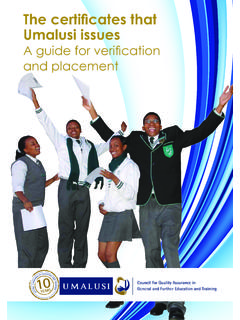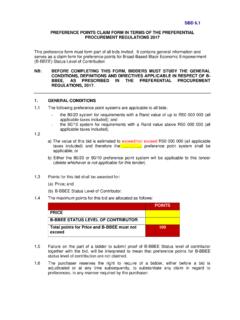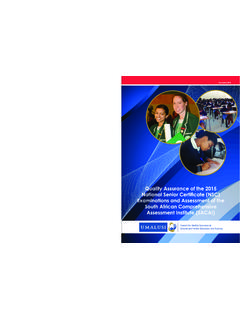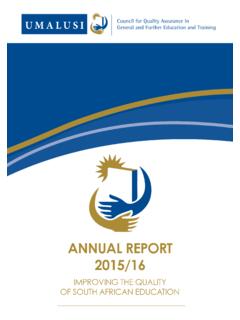Transcription of NSC Pass Requirements - Umalusi
1 NSC pass Requirements A discussion document for Umalusi on the NSC pass mark Volker Wedekind PUBLISHED BY. 37 General Van Ryneveld Street, Persequor Technopark, Pretoria Telephone: 27 12 3491510 Fax: 27 12 3491511. Email: Web: COPYRIGHT 2013 Umalusi , COUNCIL. FOR QUALITY ASSURANCE IN GENERAL. AND FURTHER EDUCATION AND TRAINING. ALL RIGHTS RESERVED. Table of Contents EXECUTIVE SUMMARY.. 1. INTRODUCTION .. 3. HISTORICAL BACKGROUND .. 5. THE CURRENT SITUATION.. 11. THE RECEPTION OF THE NSC.. 11. WHAT IS THE PURPOSE OF THE NATIONAL SENIOR certificate ? .. 12. INTERNATIONAL COMPARISONS.. 18. INTERNATIONAL EXAMINING BODIES.
2 18. Cambridge International Examination .. 18. International Baccalaureate.. 19. NATIONAL EXAMINING AUTHORITIES.. 21. Brazil.. 21. Kenya.. 22. Botswana.. 23. Singapore .. 24. Tanzania.. 24. Australia.. 24. Norway.. 25. CONCLUSION .. 25. RECOMMENDATIONS.. 27. CONCLUSION.. 31. REFERENCES .. 33. ii Executive Summary A number of commentators have raised concerns about the pass mark Requirements set for the National Senior certificate (NSC) qualification within the context of wider concerns about the quality of the schooling system. There is a perception that the pass mark is 30% and that this is too low, either because it signals that learners have only mastered 30% of the material, that the expectations are lower than they used to be, or that low minimum pass marks set low expectations.
3 This discussion paper seeks to interrogate these concerns and explore possible ways of addressing these concerns. It notes that changing the pass mark does not address fundamental concerns about quality which can only be addressed in terms of the quality of teachers, the materials, the curriculum documents and assessment systems. The paper is a discussion document. It draws on limited desktop research and some manipulation of statistical records. It begins by exploring the historical background to the NSC by examining what the historical future' of the NSC policymakers was. This refers to the imagined future educational landscape that was envisaged when the policy was written.
4 This imagined future located the NSC as a primarily academic and specialized qualification alongside more vocationally oriented alternatives for post-compulsory, post-general education learners. As the policy was put into practice this imagined future transformed into the reality that the NSC, like its predecessor the Senior certificate , was the main exit point from the schooling system. Despite public perception, the structure of the of the old Senior certificate set the pass marks for subjects at similar and even lower levels than the NSC, particularly by converting failure at one level into a pass at Standard Grade or Lower Grade.
5 Given the de facto role that the NSC plays as the main exit point from the schooling system, it is necessary to understand what role it should play, and what the patterns of achievement are that influence learner pathways and destinations. Drawing on a Systems Heuristic approach, four broad groups are identified with an interest in the NSC. The learners (and their families) need both a certificate of completion and a record of achievement that signals something about what the learner is capable of going forward. The clients' are the employers and the post-school educational institutions which seek to recruit the learners and want a mechanism that differentiates the applicants and allows for selection into different jobs or learning programmes on the basis of reliable indicators of future success.
6 The decision makers include politicians and civil servants who have political or personal accountability and have the authority to allocate resources. Their concerns are usually focused on managing perceptions and meeting targets such as pass rates at a macro level. The fourth grouping are the professionals and experts whose livelihoods are dependent on the system. Each group, and within each group, represents distinct interests that can be at odds with each other, and the system has to find ways of balancing the demands. Currently about three quarters of the candidates who pass the exam achieve a pass that provides access to diploma and degree programmes offered by universities, while very few candidates achieve the minimal pass .
7 The school leavers need to be accommodated across a spectrum of post-school institutions including, but not predominantly, at universities. Yet much of the current focus of the debate has been shaped by the NSC graduates' success at university level programmes. The NSC must of necessity fulfil a range of purposes. Whether the NSC is out of alignment with international norms is addressed through a desktop review of pass Requirements of two international systems (the Cambridge International 1. Examination and the International Baccalaureate) and seven selected countries that have different systems to South Africa.
8 The conclusion that emerges from this is that, while it is problematic to compare systems, there are a number of countries that set their pass marks at the same or even lower levels. The suggestion that 50% is the norm internationally is not borne out by the survey. The final part of the paper explores three scenarios by examining their effect on pass rates of the 2008-2011 cohorts of learners. The first scenario sets the pass requirement at a minimum of 50% per subject written. This would have a major effect reducing the pass rate to around 10%. The second scenario explores the effect that a requirement that students should achieve a 50% aggregate.
9 Here the pass rate moves up to about 40%. Neither option is deemed realistic given the general concerns about pass rates. A third scenario is based on a strengthening of the routes into higher education programmes by focusing on the Requirements for the language of learning and teaching (LOLT) which is currently set at 30%. Research on student success at university suggests that achievement in the LOLT is a good indicator of success in higher education programmes. If this were raised to 50% for the Diploma and Bachelors pass and to 40% for the Higher certificate pass there would be no impact on the overall pass rate, but some re-categorisation of passes within the NSC.
10 If this were coupled with improving standards in the examination, and a much clearer reporting of the category of NSC pass , the effect could be positive at a symbolic level (with a 50% aggregate being a viable requirement), may provide clearer signals to employers, education providers and students, without generating public hysteria about drops in the overall pass rate. The paper concludes with recommending the third scenario (or a variation of it) subject to further interrogation of the data and further research. 2. Introduction This report interrogates the appropriateness or otherwise of the pass levels set for the National Senior certificate (NSC).










